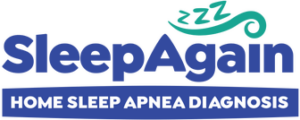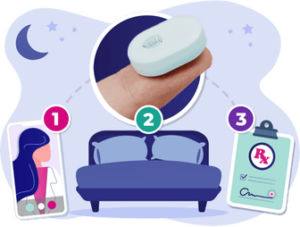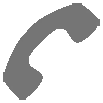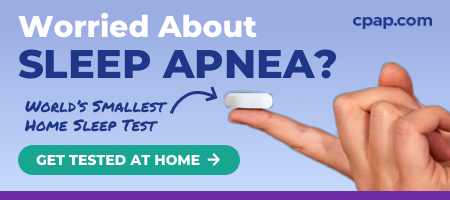According to a study from Rutgers University, an estimated 22 million Americans are living with sleep apnea, and 80% of those with moderate to severe Obstructive Sleep Apnea (OSA) go undiagnosed. Symptoms such as loud snoring, headaches, and feeling tired throughout the day are good indicators that you may have sleep apnea. The best way to know for sure is to complete a sleep study. However, there’s a lot of confusion between taking an at home sleep study vs. lab sleep study.
Keep reading to find out which is best for you and how you can avoid the complexity and wide range of insurance costs commonly associated with traditional lab sleep studies. To save you time and money, there’s a good chance you can take a simple and affordable home sleep apnea test in the comfort of your home.
We’ll be discussing the pros and cons of each approach, including an analysis of the cost, comfort, diagnostic capability, time commitment, time to treatment, equipment involved, and for whom each test is best. If you’re interested in the home sleep study vs lab sleep study discussion, read on.
How To Get Diagnosed With Sleep Apnea
If you talk to your doctor or healthcare provider about your sleep health, there’s a good chance they’ll recommend or prescribe an overnight sleep study to further assess your sleep quality. Your two options are to complete an in-lab sleep study, also known as polysomnography (PSG), or a home sleep study (HST).
A lab sleep study is far more comprehensive than a home sleep study, but due to the prevalence of undiagnosed Obstructive Sleep Apnea (OSA) in people without other health complications, an at-home sleep test is usually suitable for the majority of those who think they may have Obstructive Sleep Apnea.
Traditional polysomnography tests have been the standard approach since the late-eighties to mid-nineties, but with advancements in technology, home sleep apnea tests are an increasingly viable (and convenient) option for diagnosing Obstructive Sleep Apnea.


Order Your Home Sleep Study Kit and Take Back Your Sleep Again!
Home Sleep Study vs Lab: How Do They Compare?
In two separate blog posts, we’ve already gone in-depth on both lab sleep studies and home sleep studies, so if you’re unfamiliar with one or both, we recommend reading those first.
Here is a side-by-side comparison of an in-lab sleep study vs an at-home sleep study, followed by a section-by-section breakdown of what you can expect during either test:
Polysomnography (In-Lab) Diagnostic Capabilities
rtain types of sleep disorders. An in-lab sleep study is a more invasive yet more comprehensive test that can diagnose a wider range of different sleep disorders (not just sleep apnea) when compared to a home sleep test. Again, if you have no underlying health conditions and are only looking to find out if you have Obstructive Sleep Apnea, then a home sleep test may be your best bet.
Traditional polysomnography records brain waves, breathing effort, heart rate, oxygen levels, and muscle movements during the various stages of sleep. A lab sleep study can diagnose all three types of sleep apnea: Obstructive Sleep Apnea, Complex/Mixed Sleep Apnea, and Central Sleep Apnea, which vary based on severity as well as REM sleep disorders, sleep-related seizures, and movement disorders such as restless leg syndrome, narcolepsy, and insomnia.
Home Sleep Study Diagnostic Capabilities
A home sleep test, however, is really only qualified to diagnose Obstructive Sleep Apnea. While this may seem like a bit of a roadblock for those with a more complicated health history, it’s great news for the vast majority of people who are seeking an easy way to test for uncomplicated Obstructive Sleep Apnea. The core takeaway here is that a home sleep test has a high level of accuracy when diagnosing OSA.
The American Academy of Sleep Medicine (AASM) does not recommend using a home sleep test as a general screening method for people who are not at risk for Obstructive Sleep Apnea and who don’t display symptoms. Basically, home sleep testing shouldn’t be used as a general test if you’re curious about your sleep health, but rather, only if you suspect you may have OSA and don’t have other underlying conditions.
That said, a home sleep study can be a much more accessible option for those with employer-mandated sleep apnea screenings such as commercial truck drivers or military service members who need to be medically cleared for work.
It is estimated that two to nine percent of all adults have OSA. It’s four times more common in men and seven times more common among those who are obese. The HypnoLaus study further shows that in a cohort of 2,121 participants, 23.4% of women and 49.7% of men showed signs of moderate-to-severe sleep-disordered breathing. Women are also much more likely to develop OSA during and after menopause.
Another 2017 meta-analysis of 24 studies estimated the number of people affected by moderate sleep-disordered breathing to be 6% to 17% with older generations being affected by as much as forty-nine percent. Simply put, there are a lot of people out there with undiagnosed OSA who would almost certainly benefit from accessible home sleep testing.
Find out your risk level for Obstructive Sleep Apnea today with our free sleep apnea test!
How To Choose Between Home Sleep Study and In-Lab
An in-lab sleep study should only be used when necessary and for people who absolutely need it. Certain authorities, such as the Department of Transportation, require specific workers (such as commercial truck drivers) to be annually screened for sleep apnea.
If you or your health care provider suspect that you are at risk for Obstructive Sleep Apnea and you do not have any previous or underlying health conditions, then congratulations! You’re most likely eligible for a home sleep study.
If, however, you have a history of significant heart or lung disease, a neuromuscular condition such as ALS or MS, stroke, chronic opioid use, or significant pre-existing sleep disorders, you’ll have to do a sleep study in a lab for the most comprehensive diagnosis.
Understanding The Key Differences in Sleep Testing Equipment
What makes or breaks the sleep testing experience for a lot of people is the equipment used for the test. It’s what makes a lab sleep study so much more comprehensive than a home sleep study—though not all home sleep studies use the same equipment.
While undergoing a sleep study in a lab, you can expect to be hooked up to several electrodes attached to your chest, stomach, legs, scalp, and various points on your face. You may also be equipped with a nasal cannula to measure airflow, a chest belt to measure breath volume and frequency, and a pulse oximeter on one finger to measure oxygen saturation in the blood.
Home sleep testing equipment has come a very long way in the last decade, and there are a variety of options available for home testing. Typically, you’ll have a chest belt, pulse oximeter, nasal cannula, and chest electrode.
The more technology advances, however, the more minimalist a home test can be. The SleepAgain Home Sleep Test by Ectosense is a fantastic example. This particular HST only uses a small finger attachment, similar to a pulse oximeter, for one of the most minimalist home sleep test experiences available.
At Home Sleep Study vs Lab Sleep Study Cost
In this discussion of home sleep study vs lab sleep study, we’ve established that these tests are not made equally and have different target audiences. Perhaps the clearest example of this difference is in the cost of the tests themselves.
For many, the cost of an overnight sleep study is going to be the determining factor in whether or not they decide to participate. Using FAIR Health Consumer, we looked at the average pricing for an in-lab sleep study for five of the most populated United States cities and five smaller and more secluded cities:
| City | ZIP Code Tested | Out of Network | In-Network |
| San Antonio, Texas | 78250 | $14,933 | $7,367 |
| Knoxville, Tennessee | 37922 | $10,766 | $5,222 |
| Los Angeles, California | 90011 | $10,594 | $5,890 |
| New York City, New York | 11226 | $9,757 | $4,447 |
| Chicago, Illinois | 60629 | $8,272 | $4,580 |
| Phoenix, Arizona | 85032 | $8,259 | $3,662 |
| Lincoln, Nebraska | 68516 | $7,193 | $4,042 |
| Sheridan, Wyoming | 82801 | $7,037 | $3,775 |
| Portland, Oregon | 97206 | $5,969 | $3,230 |
| Gainesville, Florida | 32608 | $4,599 | $2,175 |
| Average Cost: | $8,738 | $4,439 |
*Please Note: Tested zip code was determined by highest population.
Despite insurance coverage, the cost of a lab sleep study in a modern setting averages around $4,500 in the United States with the potential to pay upwards of $15,000 in some extreme cases. Most healthcare providers will not schedule a lab sleep study for you without first confirming your insurance coverage, however, and the actual out-of-pocket cost is typically much lower than the bill itself.
Those with Medicare or Medicaid coverage will have much lower bills on average, but pricing depends on other factors such as the provider’s billed rate, the facility, whether you’ve already met your deductible for the year, and any other insurance you may have.
In stark contrast, you would be hard-pressed to find a home sleep apnea test that costs more than $200, regardless of your insurance policy.
You can use the FAIR Health tool to learn more about the average cost of participating in a lab sleep study in a sleep center near you. We used CPT code 95810 for testing purposes, but there are multiple options for sleep testing within the tool for a more clear comparison of what’s available.
Related Readings: Does Insurance Cover At-Home Sleep Apnea Tests? & Medicare Coverage For CPAP Equipment
Want The Most Comfortable Experience? Home Sleep Studies Are the Clear Winner
Another area that poses a significant difference in experience is the level of comfort you might enjoy during an at-home sleep study vs in-lab polysomnography.
On the home sleep test side of things, most tests are designed to be minimally invasive to provide a non-intrusive experience that allows for better sleep quality. You’ll be sleeping in your own bed—an environment that you’re familiar with, comfortable with, and most importantly, accustomed to falling asleep in.
In terms of lab sleep studies, the sheer amount of sensors and equipment will almost certainly affect your sleep quality. Then, factor in sleeping in an unfamiliar environment under observation by a sleep technologist and you have the perfect recipe for fragmented sleep.
For these reasons, sleep centers have come a long way in terms of comfort despite all of the extraneous medical equipment. A good sleep center will put effort into making the testing environment as comfortable as possible.
While it won’t compare to sleeping in your own bed with far fewer attachments (especially if you’re considering the minimalist SleepAgain device), you can expect that a sleep center will feel less like spending the night in a hospital bed and more like sleeping in a hotel room.
How Long Does a Home Sleep Study Take vs In-Lab?
While you’ll typically spend one to three nights participating in either a lab or a home sleep study, there are some key differences to be aware of.
Your Apnea-Hypopnea Index is the average number of Apneas and Hypopneas you experience per hour and is considered the most relevant metric in determining the severity of your sleep apnea.
One night of recorded sleep does not necessarily paint a full picture of your sleep health or average Apnea-Hypopnea Index (AHI), as evidenced by this 2012 study of multi-night polysomnography. However, even with a single-night sleep study, your provider should easily be able to determine your level of risk for or the severity of your sleep apnea. Keep in mind, though that with all of the extra equipment in-lab, it will be difficult for you to attain the same level of sleep quality you can expect at home—not impossible, but difficult.
It’s also worth noting that you may be asked to return for a CPAP titration study in the event you’re indicated as a candidate for CPAP therapy, though some people also undergo titration on their first night. In a titration study, you’ll also be hooked up to a CPAP machine, and your sleep technologist will test a range of pressures while you sleep to determine which pressure is best for you.
Since most home sleep studies prescribe APAP machines, a titration study is not required, and due to the minimal nature of most home sleep studies, you typically only need one night for good results. Some companies prefer to use a three-night average for a more comprehensive result, but many accomplish their goals in a single night.
How Long Does It Take To Get Results From a Sleep Apnea Test?
Finally, we have the average time you can expect to wait before you receive your sleep apnea test results.
Home sleep testing is the winner here, but it’s not to say that the results of your lab study can’t be expedited if necessary; there’s simply more data to review and analyze compared with a home sleep study. That said, most home sleep tests promise a turnaround time of less than a week, with some promising a diagnosis in as little as two days!
Once you’ve received your diagnosis and decided which route to take in acquiring your PAP equipment (assuming you were diagnosed with OSA), you shouldn’t be more than a few weeks out from the start of your sleep apnea therapy.
As a bonus, opting into an at-home sleep study—assuming you meet the criteria—can even help those that truly need lab sleep studies by reducing demand on local clinics and shortening wait times.
Sleep labs typically have long waiting periods, which can be problematic for those seeking diagnosis for more serious health concerns. It’s not uncommon to have to wait six to eight weeks, or even longer, just to get into a sleep lab, but that should not at all deter you from seeking the proper level of medical attention.
If the sleep center you were recommended to has a long waitlist, you might ‘shop around’ and try a facility in a nearby city instead. Despite long waits, remember that a home sleep test is not a substitute for a lab sleep test for those that genuinely need it.
All said and done, home testing is king when it comes to quick results and overall time to getting relief from Obstructive Sleep Apnea if you don’t have other underlying health conditions.
The Bottom Line
There are pros and cons to each type of sleep study, so hopefully you now have a better understanding of which one might better suit your needs. While not created equal, there are major benefits to being tested—period.
If you’ve been told repeatedly that you’re a loud snorer, are constantly fatigued during the day, or never seem to wake up feeling refreshed, it’s a great idea to talk to your healthcare provider or book a consultation with our telemedicine partner today to discuss your options for home sleep apnea testing!





